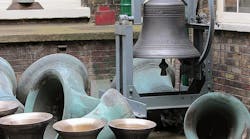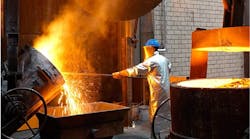Brembo North America’s gray iron foundry in Michigan continues to draw attention and praise — including for its new vision of metalcasting.
The Brembo North America gray iron foundry in Homer, MI, had been earning attention from metalcasters for several years prior to its opening last spring. When it announced the new capacity project in 2014, the brake specialist made clear its intention to be present in the region’s automotive supply chain, customizing its production capabilities in line with its own product and technologies standards. Those standards had previously been established with a new foundry project in Poland, and continue to be demonstrated by Brembo’s development of an aluminum foundry complex in Mexico.
But the Michigan project now has drawn recognition and praise of a different sort: The project was among a short list of honorees earning the Engineering Society of Detroit’s 43rd Annual ESD Construction & Design Award, with acknowledgement going equally to the new building’ owners, designers, and constructors, with credit for outstanding team achievements and innovative uses of technology.
In addition to Brembo North America, the ESD Construction & Design Award was presented to Foundry Solutions & Design, the engineering design group that conceived and planned the foundry operation; NSA Architects, Engineers, Planners, which handled the aesthetic and overall design, and The Christman Company, the project’s general contractor.
Brembo, headquartered in Bergamo, Italy, specializes in manufacturing disc brakes, clutches, seats, seat belts, and other general automotive and automotive racing components, which are supplied to automakers and motor sports manufacturers in Europe and North America. Brembo operates in 16 countries and employs over 7,500 engineers, designers, and other technicians.
Brembo acquired the Michigan site in 2007 with its purchase of the Hayes-Lemmerz Automotive Brake Components division. Then, the 440,000-ft2 operation was strictly involved in machining of discs and drums for OEMs and caliper and corner-module assembly. Seven years later it appointed FS&D and NSA to develop a greenfield foundry adjacent to the machining operation, with a stated investment of $100 million.
With an estimated capacity of 80,000 tons/year of brake discs, the new plant was described by Brembo’s deputy executive chairman as part of a vertical integration strategy.
The steel-framed building consists of three major activity centers, with varying roof heights and clear spans: the foundry, a warehouse center, and an administration and employee service center.
The foundry is the plant’s primary focus, and includes a complex of tunnels and vaults for process conveyors; pouring lines and a cooling tunnel for finished castings; a tower for processing of foundry sand; dust collection systems; a “skybox” control room, with offices and conference rooms; the melt deck with tandem induction melt furnaces; scrap bins for incoming raw materials; and support areas for compressors, electrical gear, a backup generator, and maintenance needs.
The foundry also includes structural platforms and mezzanines, reached by ladders and stairs; met laboratory; casting return tunnels; rail systems for maintenance and service bridge cranes. The core of Brembo North America’s production activity is the spacious melt shop, which is supplied with scrap metal magnetically drawn from scrap bins and deposited in precisely measured volumes into the induction melting furnaces.
The foundry is built on heavy concrete foundations, with integral walls, slabs, and platforms supporting both melting and pouring furnaces. The sand tower rises 80 feet above a 42-in. thick concrete pad.
The warehouse building links the foundry to the existing machining plant, and was designed to incorporate a high-bay automated racking system in the future. Castings are stored there until they are scheduled for finish machining.
The administration and employee service building functions as a reception for visitors, and exhibits a high degree of design detail, shaped like the Brembo logo, with shiny, curved finishes, red accents, and lobby skylight. In addition to a visitor lobby, it has conference facilities, offices, a cafeteria, and support services.
Brembo’s Michigan foundry is designed to change the impression that many people have of foundries, within the metalcasting industry and outside of it: It’s not simply a functional design. Brembo seeks to present the high value of its design capabilities as well as positive aesthetic standards throughout the facility, in particular with clean-line shapes and visual aspects, as well as bright red accents.
The skybox in the middle of the plant is one of the highlights of the interior design, and provides the engineers and others with a clear view of all processing activities. From a glass enclosure they can monitor the activities below, melting, pouring, and molding. And, with an extensive dust-collection system the interior space remains clean of the dust and particulate matter that frequently plague metalcasting operations.
In connection with current and emerging building design standards, the project incorporated a variety of environmentally sustainable materials and practices. LED lighting is used for all interior and exterior fixtures. A solar water heater provides hot water to the employees’ facilities. And, the operation’s technical specifications were developed to minimize the number of stacks servicing the plant, in order to minimize dust handling.
Special consideration was taken in the design of the plant’s mechanical systems, mainly in the selection of indirect gas-fired heating and direct expansion cooling, rather than radiant heat derived from hot water coils (and the necessary boilers, pumps, piping, controls, and back-up heating systems). This approach avoids the need for the central systems and provides a more cost effective installation.
The plant also has an emergency backup cooling water system, in case of a loss of power to the melting furnace cooling water system. The backup is designed with a system of storage tanks and pumps that supply an adequate flow of water (gpm) for an extended period of time (storage volume).
The design and construction was carried out over an expedited, 14-month schedule that included integrated equipment installation. The design and engineering team coordinated with Brembo throughout, meeting each milestone and maintaining a safe, prompt, and orderly schedule. Daily meetings helped to coordinate upcoming tasks and schedule, and to schedule just-in-time deliveries.
The recognition by the Engineering Society of Detroit brings credit to Brembo’s effort to assume its place in the regional automotive supply chain with a landmark operation that alters manufacturing industry and community standards for metalcasting. It also acknowledges the roles assumed by Foundry Solutions & Design, NSA Architects, and Christman, to fulfill this new vision of foundry production.











